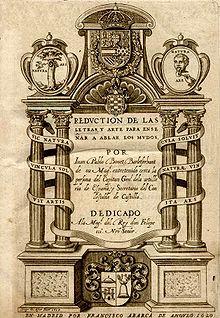- History of sign language
-
The recorded history of sign language in Western societies extends from the 16th century, as a visual language or method of communication. Sign language is composed of a system of conventional gestures, mimic, hand signs and finger spelling, plus the use of hand positions to represent the letters of the alphabet. Signs usually represent complete ideas, not only individual words.
Most sign languages are natural languages, different in construction from the aural languages used in proximity to them, and are employed mainly by deaf and mute people in order to communicate.
Contents
Development of Sign Language
Sign Languages have existed since deaf people have been around. Universally, where the deaf can be found, a manual form of conveying communication can also be found.
The written history of sign language began in the 17th century in Spain. In 1620, Juan Pablo Bonet published Reducción de las letras y arte para enseñar a hablar a los mudos (‘Reduction of letters and art for teaching mute people to speak’) in Madrid.[1] It is considered the first modern treaty of phonetics and speech therapy, setting out a method of oral education for the deaf by means of the use of manual signs, in the form of a manual alphabet to improve communication among and with the deaf.
From the language of signs of Bonet, Charles-Michel de l'Épée published his alphabet in the 18th century, which has arrived basically unchanged until the present time.
Standardized sign languages have been used in Spain and Italy since the 17th century and in France since the 18th century for the instruction of the deaf. Old French Sign Language was developed and used in Paris by the l’Abbé Charles Michel de l’Épée in his school for the deaf. These languages were always modeled after the natural sign languages already in use by the deaf cultures in their area of origin, often with additions to show aspects of the grammar of the local spoken languages.
In 1755, Abbé de l'Épée founded the first public school for deaf children in Paris. His lessons were based upon his observations of deaf people signing with hands in the streets of Paris. Synthesized with French grammar, it evolved into the French Sign Language. Laurent Clerc, a graduate and former teacher of the French School, went to the United States with Thomas Hopkins Gallaudet to found an American School for the deaf.
The 18th permanent school for the deaf was established in Hartford, Connecticut; others followed. In 1817, Clerc and Gallaudet founded the American Asylum for the Deaf and Dumb (now the American School for the Deaf). In 1864, a college for deaf people was founded in Washington D.C. Its enabling act was signed by Abraham Lincoln and was named “The National Deaf-Mute College” (later "Gallaudet College" (1894), and then renamed "Gallaudet University") in 1986.
Engravings of Reducción de las letras y arte para enseñar a hablar a los mudos (Bonet, 1620): See also
References
External links
- History of sign language in the United States (American School for the Deaf Website).
- History of the Royal National Institute for Deaf People (sign language in the UK).
- American Sign Language (ASL) History Lesson
- Pablo Bonet, J. de (1620) Reduction de las letras y Arte para enseñar á ablar los Mudos, Biblioteca Digital Hispánica (BNE).
Categories:- Deafness
- Deaf culture
- Education for the deaf
Wikimedia Foundation. 2010.









